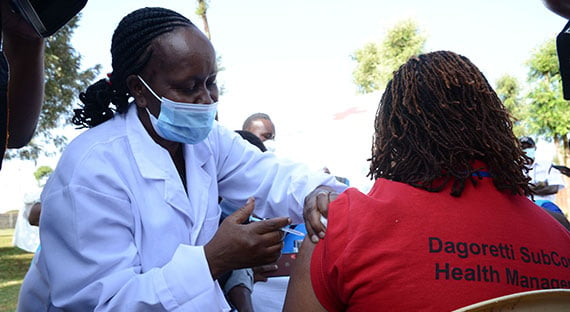
A health care worker administers a vaccine to her colleague in Nairobi, Kenya. An IMF loan in May helped cover the cost of additional spending on health. (Photo: Dennis Sigwe / SOPA Images/Sipa/Newscom)
IMF Loan to Support Economic Recovery in Kenya
March 18, 2021
Kenya’s economy is now picking up speed after the COVID-19 shock, but the pandemic has left deep imprints on the country’s fiscal and debt positions.
Related Links
Earlier in the year, IMF staff and the country’s authorities reached a provisional agreement on a program to support the next phase of the country’s response to the health crisis.
IMF Country Focus spoke to the IMF mission chief for Kenya, Mary Goodman, who explained that the loan would be used to support the government's reform plans and help meet financing needs.
What was the impact of the COVID-19 pandemic on Kenya and its economy? And how did the country respond?
Like many other countries around the world, Kenya was hit hard by the COVID-19 shock. The disruption in global trade and travel, and the containment measures put in place to limit the spread of the virus, meant that economic activity contracted sharply in Kenya in the second quarter of 2020.
School closures, curfews, and restrictions on public gatherings transformed daily life. Some lost their jobs, while many more felt the pressure from a loss of income. For the most vulnerable, this pressure translated into real hardship.
Forceful early actions to support the economy in the face of such an unprecedented shock included immediate temporary cuts in personal income taxes and corporate income taxes, a temporary reduction in the rate of the value-added tax from 16 percent to 14 percent, and revisions to the budget to accommodate additional spending on health and social protection.
The Kenyan Central Bank helped cushion the blow with interest rate cuts, and with liquidity injections to ensure the continued smooth functioning of Kenya’s financial system. It also encouraged banks to offer borrowers the chance to postpone loan payments. The temporary elimination of fees for mobile money transactions reduced costs for users and promoted transition from physical exchange of cash to a safer means of payment.
As a result, while the shock was large, the impact on economic growth has been contained. On a year-on year-basis, output growth recovered from -5.5 percent in the second quarter of 2020 to -1.1 percent in the third quarter. Growth in 2020 overall is likely to have been close to zero and it is projected to bounce back strongly in 2021.
While economic activity is picking up, many challenges remain. Public health is still under pressure with the rollout of COVID-19 vaccines just getting started. Higher poverty has set back progress towards Kenya’s development goals. Kenya’s fiscal and debt positions have also worsened, adding to difficulties that existed even before the shock.
The IMF provided emergency pandemic support last May, why is a Fund program needed now when the economy is recovering?
In May, the IMF provided $739 million in the form of an interest-free loan under the Rapid Credit Facility to help Kenya weather the initial shock. This helped to cover the cost of additional spending on health, social protection, and speeding up payments to bolster the economy.
The new program with the IMF will support the next phase of the government's COVID-19 response. Combining arrangements under the Extended Fund Facility and Extended Credit Facility, it provides for $2.4 billion in low-cost financing over the next three years. Other development partners will also be providing substantial amounts of concessional financing. Without this help, Kenya would have to aggressively cut spending on investment and social programs, making it more difficult to achieve a durable and inclusive recovery.
Does the IMF propose fiscal consolidation for Kenya under the new loan arrangement?
As the pandemic continues to threaten both lives and livelihoods, the authorities are determined to protect vulnerable groups while also setting the stage for a strong recovery. The program enables the health, social, and development spending that is needed. This is being complemented by accommodative monetary policy.
The program also supports the authorities’ plan for fiscal consolidation over the medium term. Kenya is at high risk of debt distress and reducing the fiscal deficit as the COVID-19 shock fades is essential. The government has already begun reversing some of the extraordinary measures introduced at the start of the shock. This includes the temporary tax cuts, which ended at the start of 2021.
The 2021 Budget Policy Statement, which was released recently, gives an overview of Kenya’s priorities and fiscal policy goals. It envisages a multi-year effort through a combination of revenue mobilization and spending rationalization measures that will reduce the fiscal deficit to below 4 percent of GDP by fiscal year 2024/25. This will put the ratio of public debt to GDP firmly on a downward path.
The impact of fiscal consolidation would need to be softened by more efficient spending. Supported by transparent use of funds, this will help ensure that government spending is channeled to the areas where it is most needed. It will also free up resources for private investment. Together these steps will help put in place conditions for durable and inclusive growth, which should allow Kenya to quickly resume progress on its development goals.


